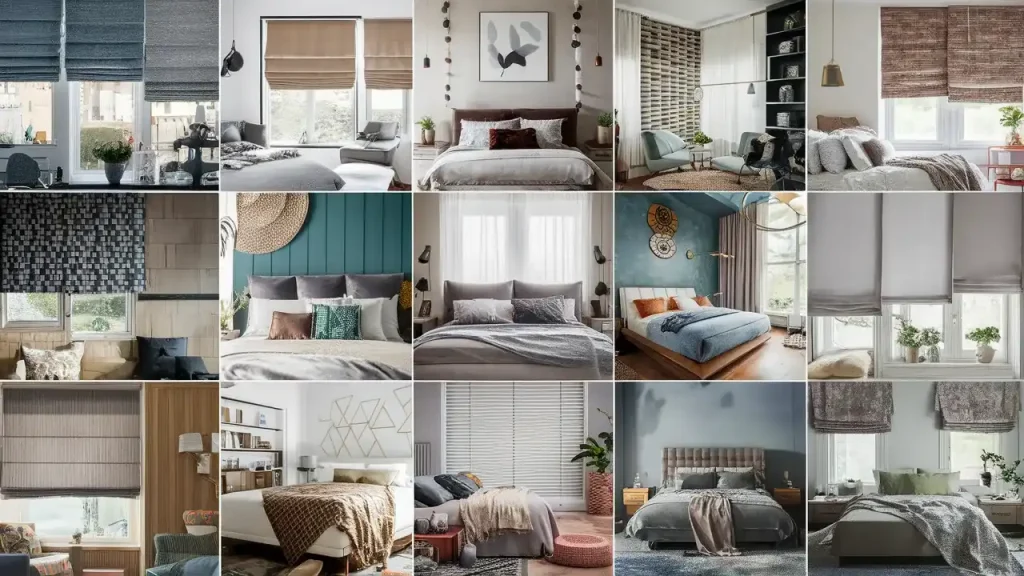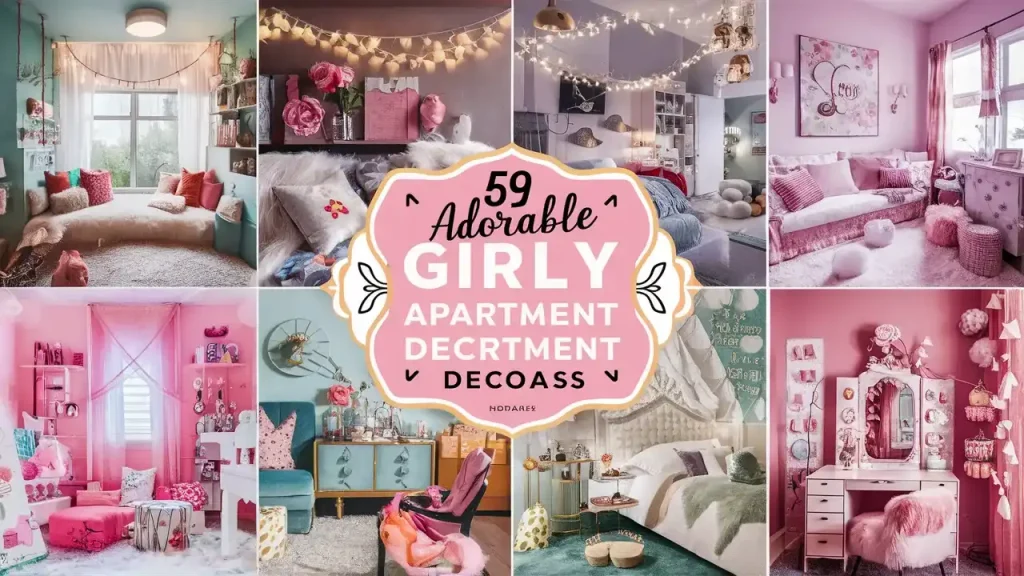Mud kitchens are a fantastic way to encourage outdoor play, sensory exploration, and imaginative fun. They provide children with a hands-on experience that fosters creativity while allowing them to engage with nature. Whether you have a large backyard or a small outdoor space, there’s a mud kitchen design to fit every need.
In this article, we’ll explore 25 unique and inspiring mud kitchen ideas that you can either DIY or purchase. These setups range from rustic and upcycled designs to modern, space-saving options that suit different styles and budgets. Let’s dive into the first 15 ideas!
1. Rustic Wooden Mud Kitchen
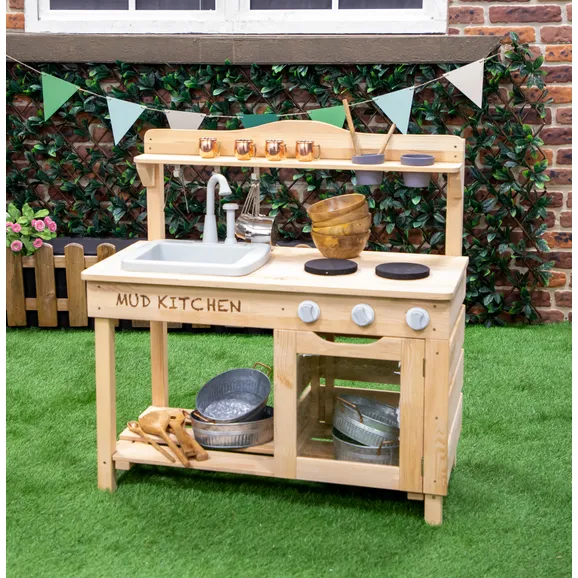
A classic wooden mud kitchen offers a timeless charm that blends seamlessly with nature. Made from natural wood or repurposed planks, this design is sturdy, eco-friendly, and aesthetically pleasing.
For a DIY approach, you can use wooden pallets, reclaimed lumber, or fence panels to build a simple frame with a countertop. Add a deep metal bowl or an old sink to serve as a mud basin. Wooden crates or shelves provide storage space for utensils and “ingredients” like leaves, twigs, and pebbles.
To enhance the rustic feel, consider staining the wood or letting it age naturally. You can also attach small hooks for hanging pots and pans. A few chalkboard labels or a small sign reading “Mud Café” will complete the look, making it a delightful addition to any backyard.
2. Upcycled Pallet Mud Kitchen
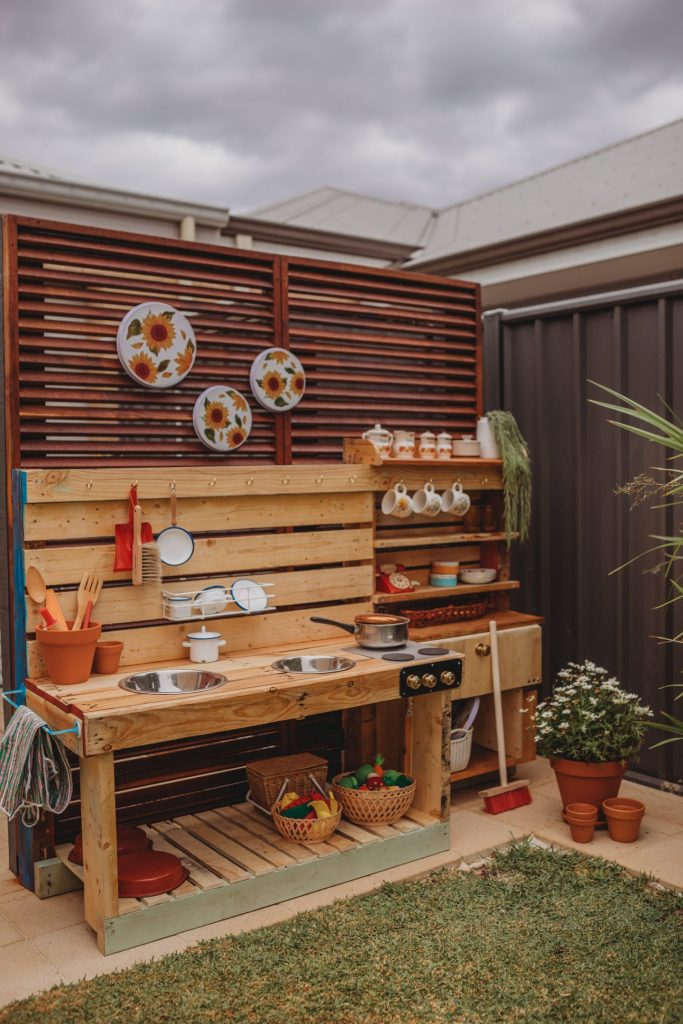
If you love eco-friendly projects, an upcycled pallet mud kitchen is a perfect choice. Wooden pallets are easy to find, affordable, and make for a sturdy, rustic outdoor play station.
Start by securing a couple of pallets together to form a sturdy base and back panel. Add a countertop using an extra piece of wood, and incorporate a plastic basin or old sink for mixing up “mud pies.” For added storage, attach shelves or small baskets to hold play utensils and nature-inspired ingredients.
This setup is budget-friendly and can be customized with a coat of non-toxic paint to match your backyard decor. Adding a chalkboard menu or a small planter with herbs will elevate the design, making it a functional and fun outdoor play area for kids.
3. Compact Balcony Mud Kitchen
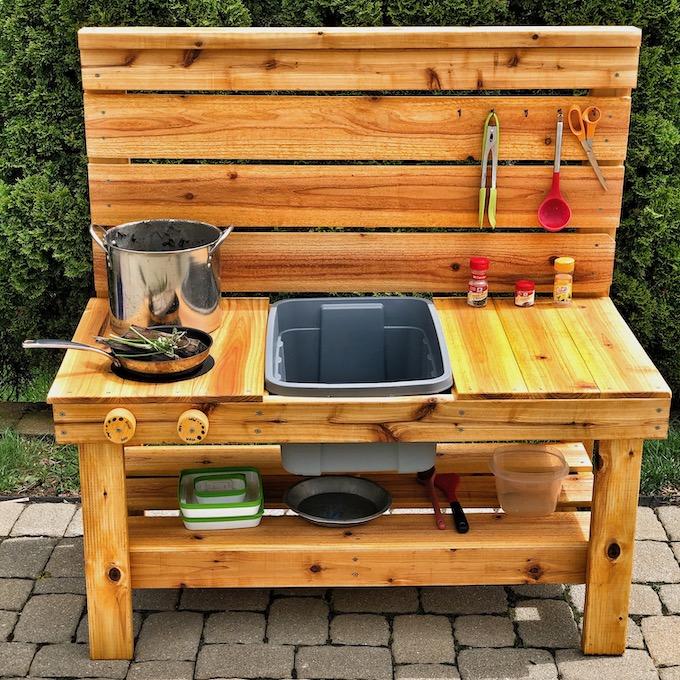
Not everyone has a spacious backyard, but that doesn’t mean your child has to miss out on the fun. A compact mud kitchen is ideal for small spaces like patios, balconies, or even side yards.
You can use a sturdy table or an old kitchen cart as the base. Add a small bowl for mixing, a storage shelf for ingredients, and a couple of hooks for hanging tiny pots and spoons. Consider a foldable or wheeled design that allows you to tuck it away when not in use.
To prevent messes in tight spaces, place a plastic mat underneath or position the setup near a drain. This way, your child can enjoy mud play without worrying about cleanup.
4. Vintage-Inspired Mud Kitchen
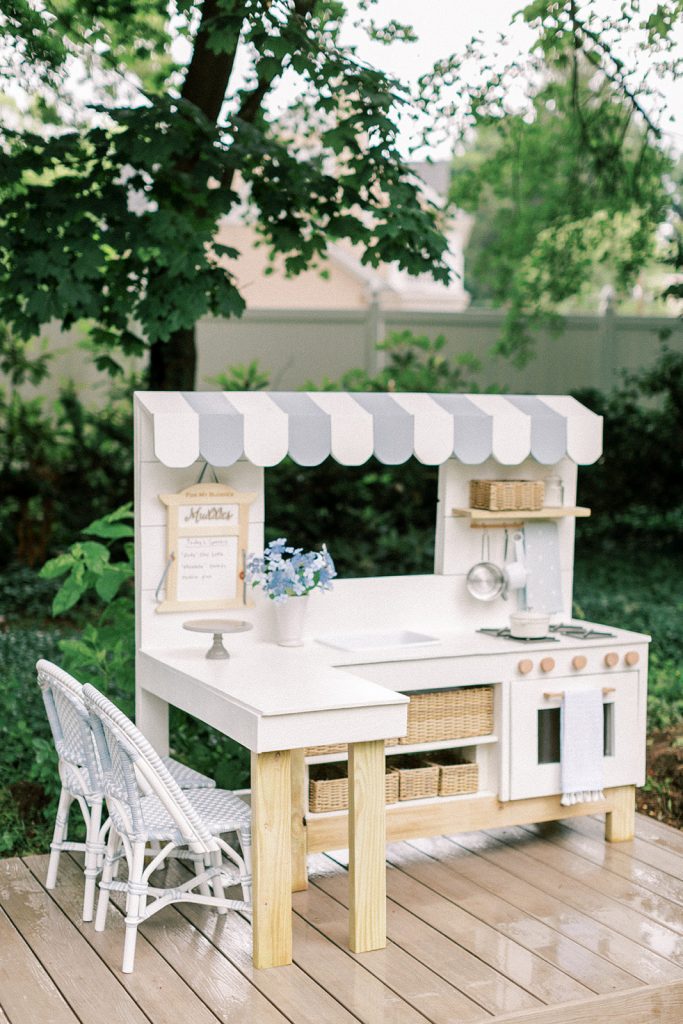
For a whimsical touch, a vintage-themed mud kitchen brings nostalgia and charm to outdoor play. This setup can be created using old furniture, like an upcycled dresser or wooden hutch, painted in soft pastels or distressed finishes.
Incorporate antique-style kitchen accessories like metal bowls, enamel pitchers, and wooden spoons to give it a timeless feel. Adding a few decorative elements, such as floral prints, lace curtains, or vintage-style signs, will enhance the aesthetic.
This type of mud kitchen is perfect for parents who love shabby chic or farmhouse decor, making the outdoor play area just as beautiful as it is functional.
5. Deluxe Two-Station Mud Kitchen

A two-station mud kitchen is perfect for siblings or playdates, allowing multiple children to cook up messy creations at the same time.
This setup typically includes two sinks or mixing stations, extra counter space, and multiple shelves for storage. Consider adding a divider to create individual workspaces, preventing kids from bumping into each other.
For a deluxe touch, include a water dispenser or a hose attachment so children can easily fill up their pots. A larger kitchen also provides room for more pretend play elements like a mini stove or oven.
6. DIY Mud Kitchen with Chalkboard
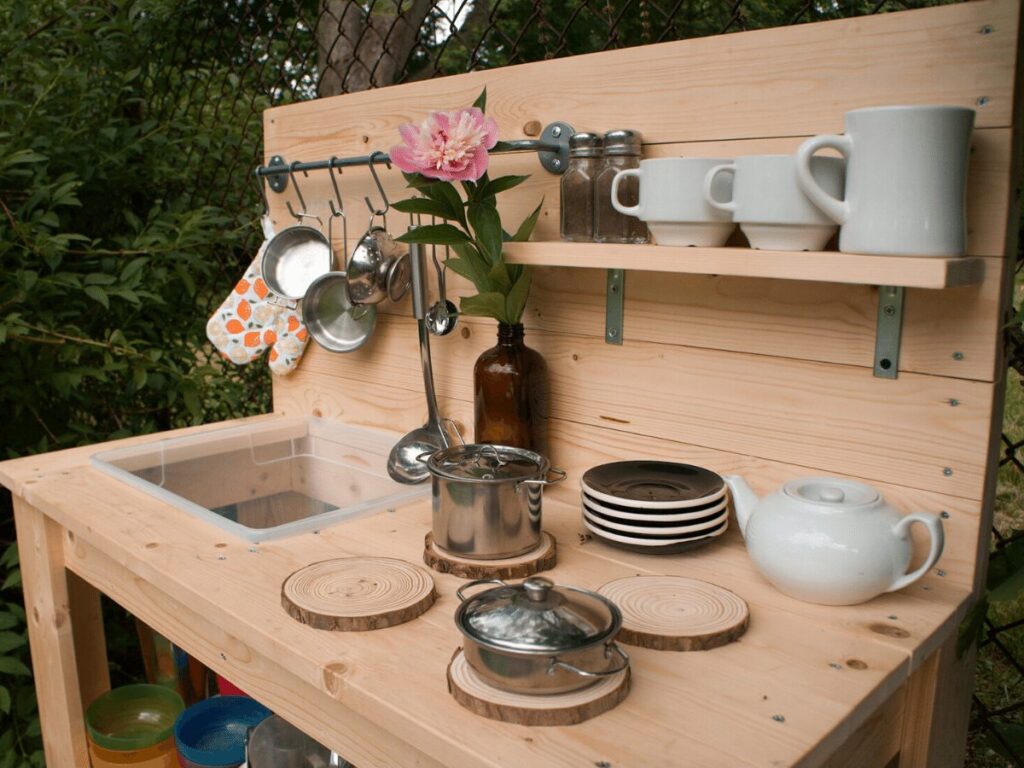
A chalkboard mud kitchen adds an interactive and educational element to outdoor play. By attaching a chalkboard to the back of the kitchen, kids can write down their recipes, menu items, or draw creative designs.
Building this kitchen is simple—use wooden planks for the base and install a chalkboard panel at the back. Add a few shelves, a mixing bowl, and a hook for utensils. A small piece of sponge or rag attached with a string will help kids erase their chalkboard writings easily.
This idea is great for children who love both messy play and drawing, making it a double-duty play station.
7. Tree Stump Mud Kitchen
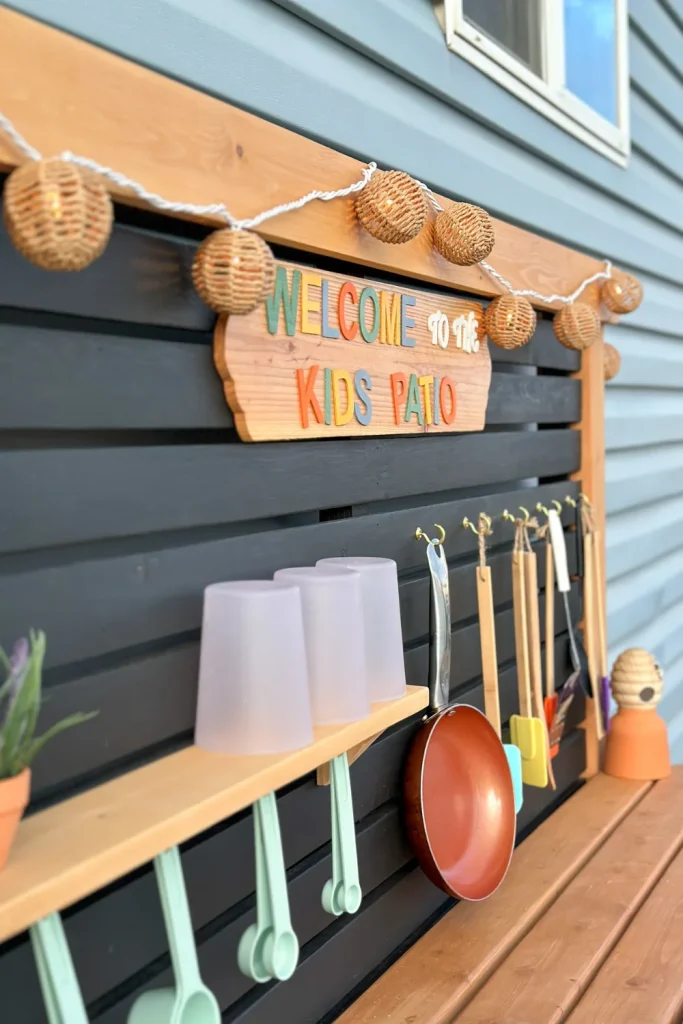
Nature lovers will appreciate a mud kitchen built around tree stumps. This design utilizes natural materials, creating a unique, eco-friendly play area that blends beautifully with the surroundings.
You can use large tree stumps as the countertop or individual workstations. Arrange them in a circle to create a communal mud kitchen, or place them in a row for a linear setup.
For added functionality, incorporate a wooden board with attached bowls and a small shelf for storing mud-making tools. This design is perfect for families who enjoy rustic, nature-inspired outdoor play spaces.
8. Farmhouse-Style Mud Kitchen
A farmhouse-style mud kitchen embraces country charm with classic design elements. Whitewashed wood, galvanized metal accents, and rustic decor create a cozy, inviting feel.
You can upcycle an old cabinet or wooden table, painting it in neutral tones for that farmhouse appeal. Metal buckets serve as sinks, and a wooden crate can be used for storage. To add character, hang a mini apron, attach a sign that says “Farm Fresh,” and include small pots of herbs for a real farm-to-table experience.
9. Budget-Friendly Plastic Tub Mud Kitchen
If you’re looking for an easy and affordable option, a plastic tub mud kitchen is the way to go. Simply use two or three large plastic storage bins as the base and sinks. Stack them on a sturdy wooden frame or arrange them on the ground for easy access.
This setup is great for younger children who enjoy scooping, pouring, and mixing. Since plastic tubs are lightweight, they can be moved around easily, making this a portable and adaptable option.
10. Outdoor Café Mud Kitchen
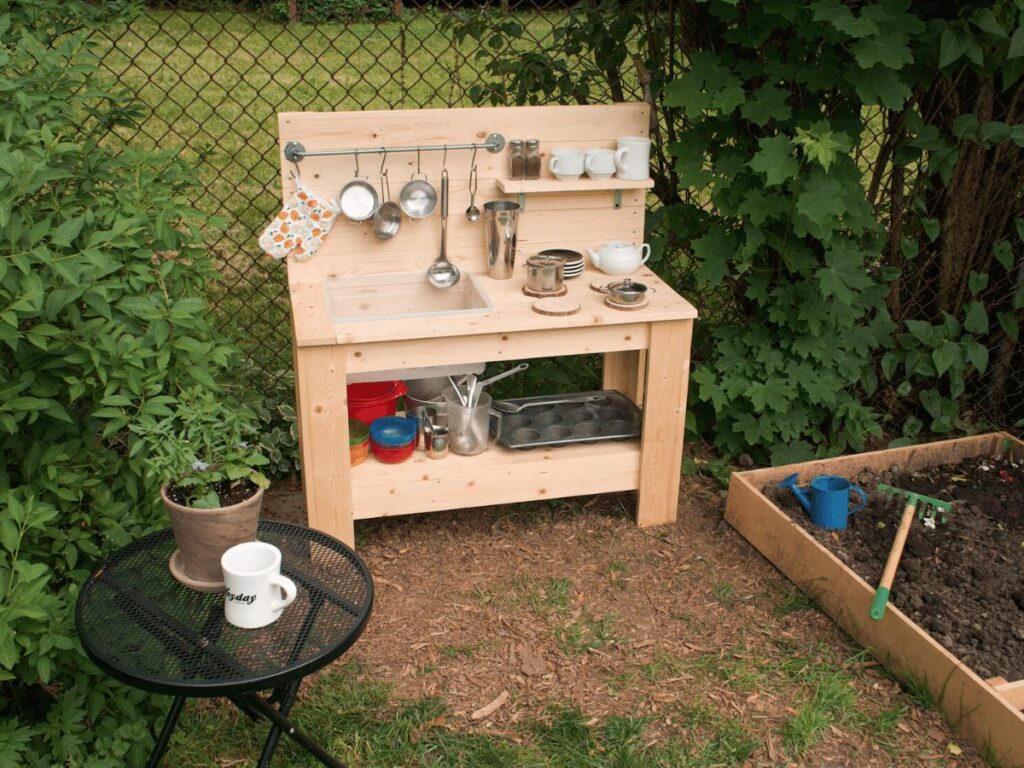
Encourage social play by turning your mud kitchen into a pretend outdoor café. This design includes a counter area where kids can take orders, prepare “dishes,” and serve their customers.
To enhance the experience, add a chalkboard menu, a small table with chairs, and pretend cash registers. This mud kitchen is perfect for kids who love role-playing and engaging in interactive storytelling.
11. Portable Folding Mud Kitchen
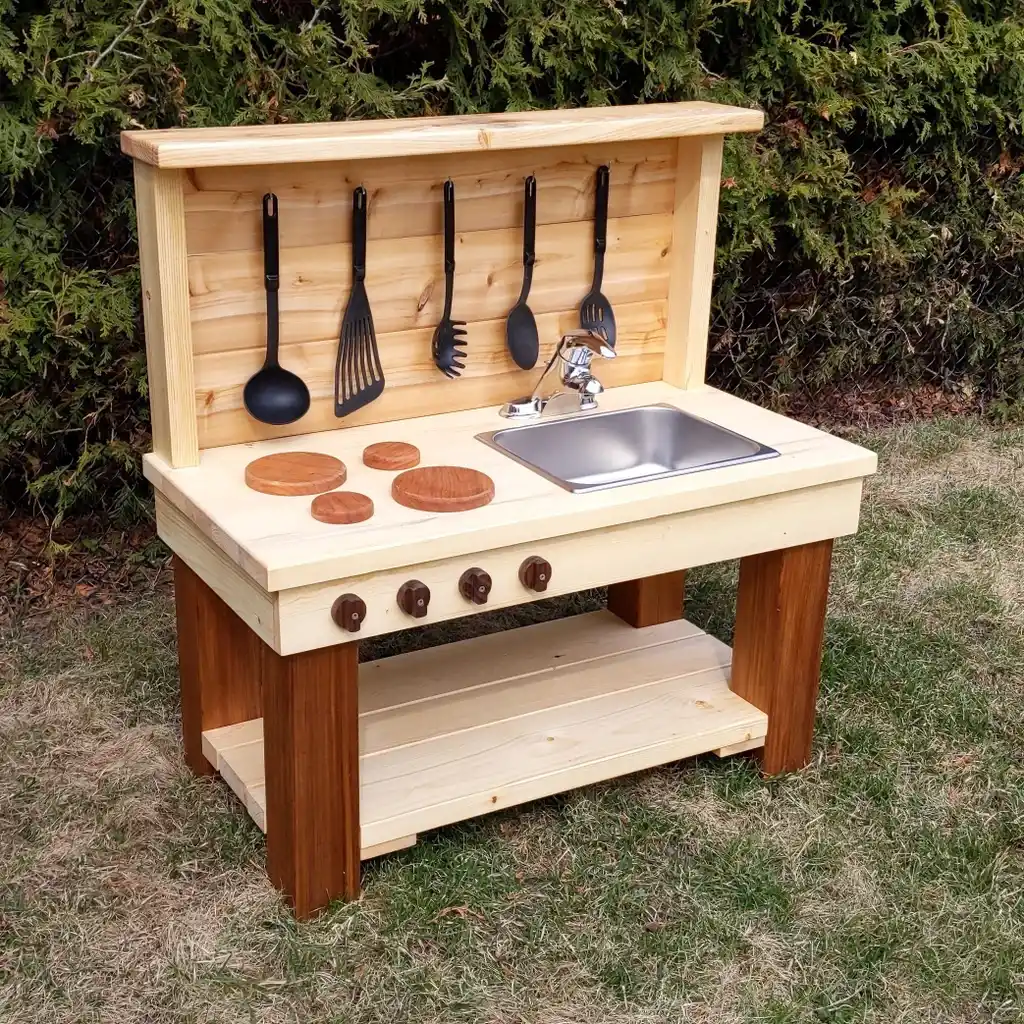
A foldable mud kitchen is ideal for families who need a space-saving solution. It can be packed away when not in use and easily transported for camping trips or outdoor gatherings.
This design typically features a compact wooden or metal frame with fold-down shelves and a detachable sink. Some models even include wheels for added mobility.
12. Fairy-Themed Mud Kitchen

For children who love fantasy play, a fairy-themed mud kitchen brings a magical touch to the backyard. Decorate with tiny fairy doors, twinkle lights, and painted mushrooms.
A small garden area with flowers and mini houses can make the space even more enchanting. Fairy-themed dishes and utensils add to the whimsical experience, sparking endless imaginative play.
13. Water & Sand Mud Kitchen Combo
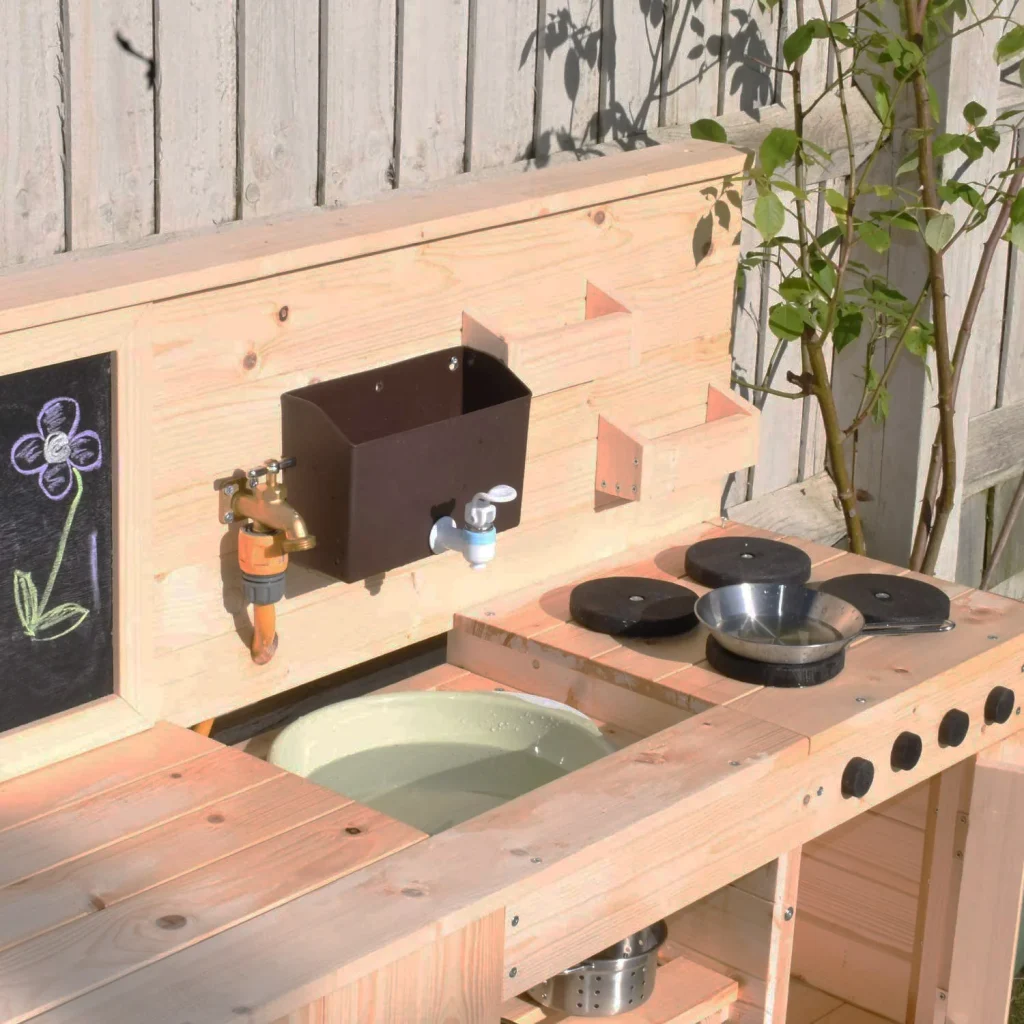
Combine mud play with water and sand for a versatile sensory experience. This kitchen setup includes separate basins for mud, sand, and water, allowing children to mix and explore different textures.
Ideal for warm climates, this setup provides hours of engaging outdoor fun. Adding a small water pump or hand-pumped spout can make it even more exciting.
14. Repurposed Cabinet Mud Kitchen
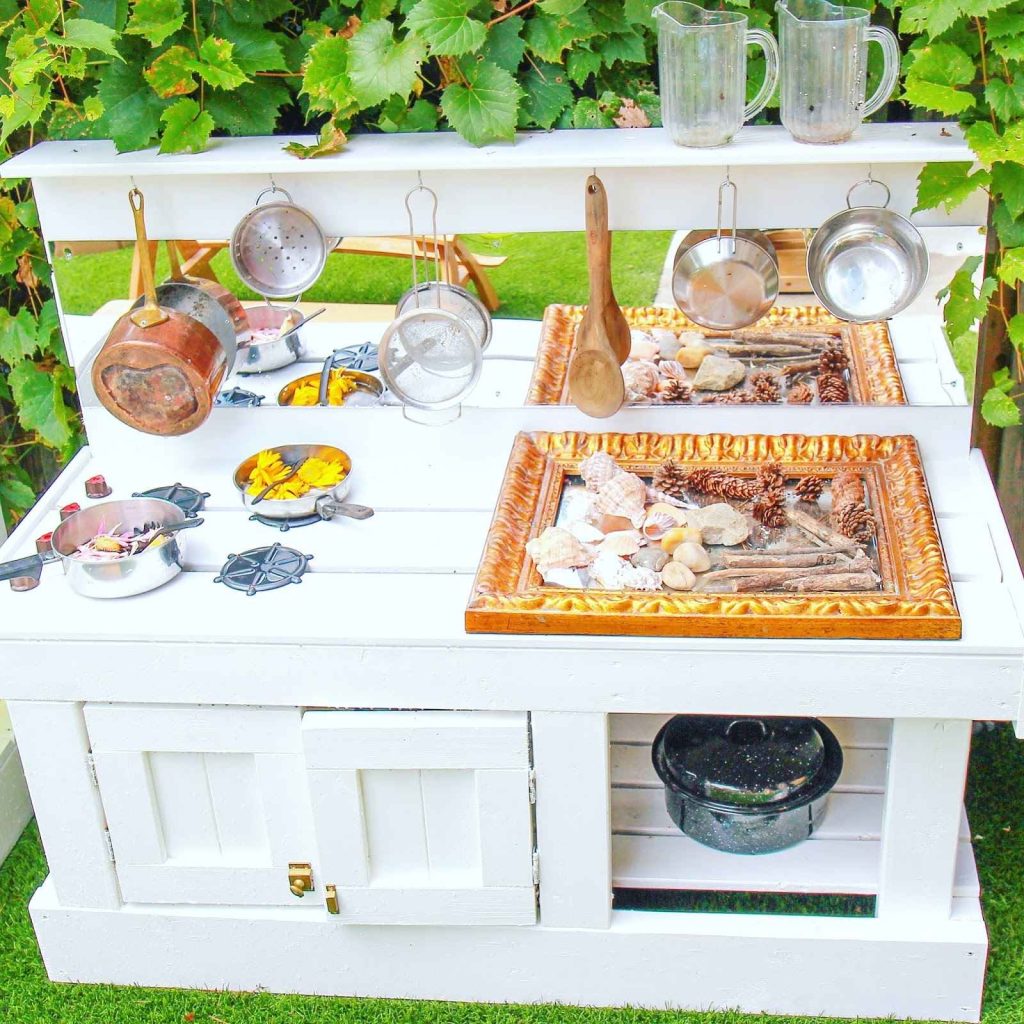
An old cabinet or dresser can easily be transformed into a stylish and functional mud kitchen. Remove drawers for open shelving, install a sink, and repaint it in fun, kid-friendly colors.
This approach gives new life to unwanted furniture while creating a durable outdoor play area.
15. Nature-Infused Mud Kitchen
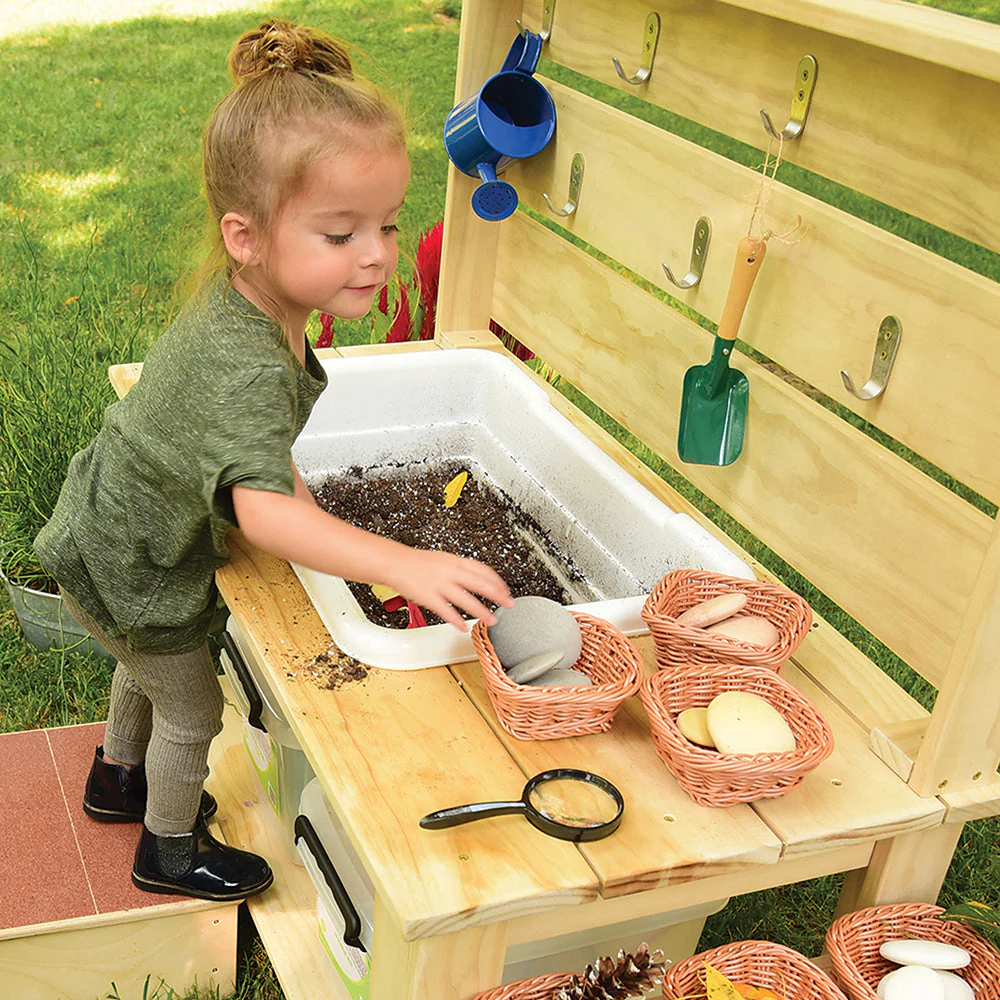
Incorporate natural elements like stone countertops, bamboo utensils, and wooden bowls for a nature-inspired kitchen. This setup blends seamlessly into forested or garden areas.
Adding potted plants, pebbles, and wooden signs enhances the earthy aesthetic, creating an immersive outdoor play experience.
16. Colorful Painted Mud Kitchen
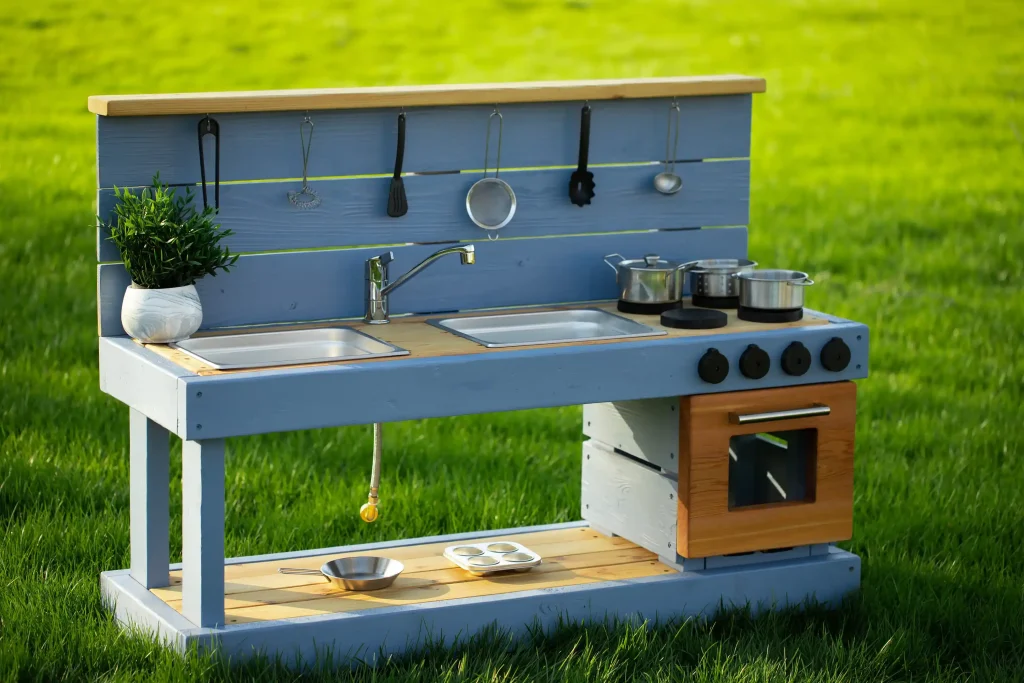
A splash of color can turn a simple mud kitchen into a vibrant, exciting play area. Whether you opt for bright rainbow hues or soft pastel tones, painting your mud kitchen gives it a lively, customized look.
Use weatherproof, non-toxic paint to ensure the colors stay fresh despite exposure to the elements. You can create fun patterns like polka dots, stripes, or even chalkboard-painted sections where kids can write down their “recipes.”
To enhance the colorful theme, add coordinating play utensils, painted flower pots, or cheerful decorative signs. This setup is perfect for parents who want to create a playful, inviting atmosphere in their backyard.
17. Mud Kitchen with Real Cooking Accessories
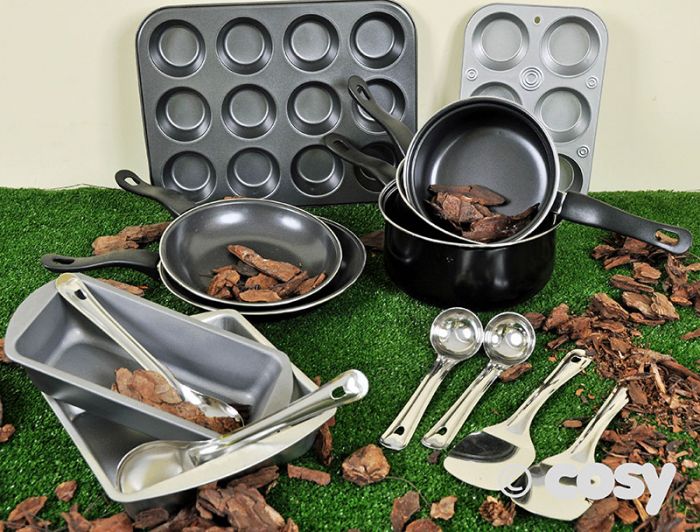
For kids who love to mimic real-life kitchen experiences, adding actual cooking accessories makes mud play even more immersive. Think miniature pots, pans, rolling pins, measuring cups, and whisks—all sourced from thrift stores or old kitchen drawers.
You can go a step further by including a wooden spice rack with labeled jars for “ingredients” like sand, leaves, and pebbles. If you have access to child-safe herbs like mint, basil, or rosemary, adding them can introduce real cooking scents into playtime!
This setup provides a realistic cooking experience, helping kids build confidence and motor skills as they “bake” their mud pies and “brew” their nature-inspired soups.
18. DIY Crate Mud Kitchen

Wooden crates are versatile, budget-friendly, and perfect for a quick DIY mud kitchen. Simply stack a few crates to create a countertop, storage shelves, and even seating.
For an easy design, use two stacked crates as the base, with a wooden board placed on top as a work surface. A metal or plastic bowl can serve as the sink, while hooks on the side hold mini kitchen tools.
This modular design allows for easy rearrangement—kids can mix and match the crates to create different setups as their play evolves. It’s a great low-cost, high-impact project for parents who love upcycling.
19. Adventure-Themed Mud Kitchen
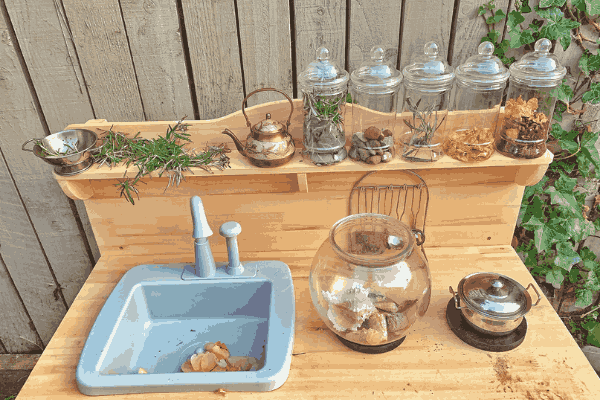
Turn your mud kitchen into an explorer’s base camp with an adventure theme! This setup works great for kids who love nature, animals, and outdoor expeditions.
Use earthy colors like green, brown, and beige for a nature-inspired feel. Hang up a world map, compass decorations, or wooden signs with “Camp Kitchen” written on them. Add small wooden boxes labeled “Explorer’s Supplies” to store pretend food, magnifying glasses, and binoculars.
For extra fun, include a “treasure chest” filled with hidden gems (painted rocks), tiny fossils, or leaves from different trees. This setup encourages kids to incorporate storytelling and nature exploration into their mud play.
20. Sensory Bin Mud Kitchen
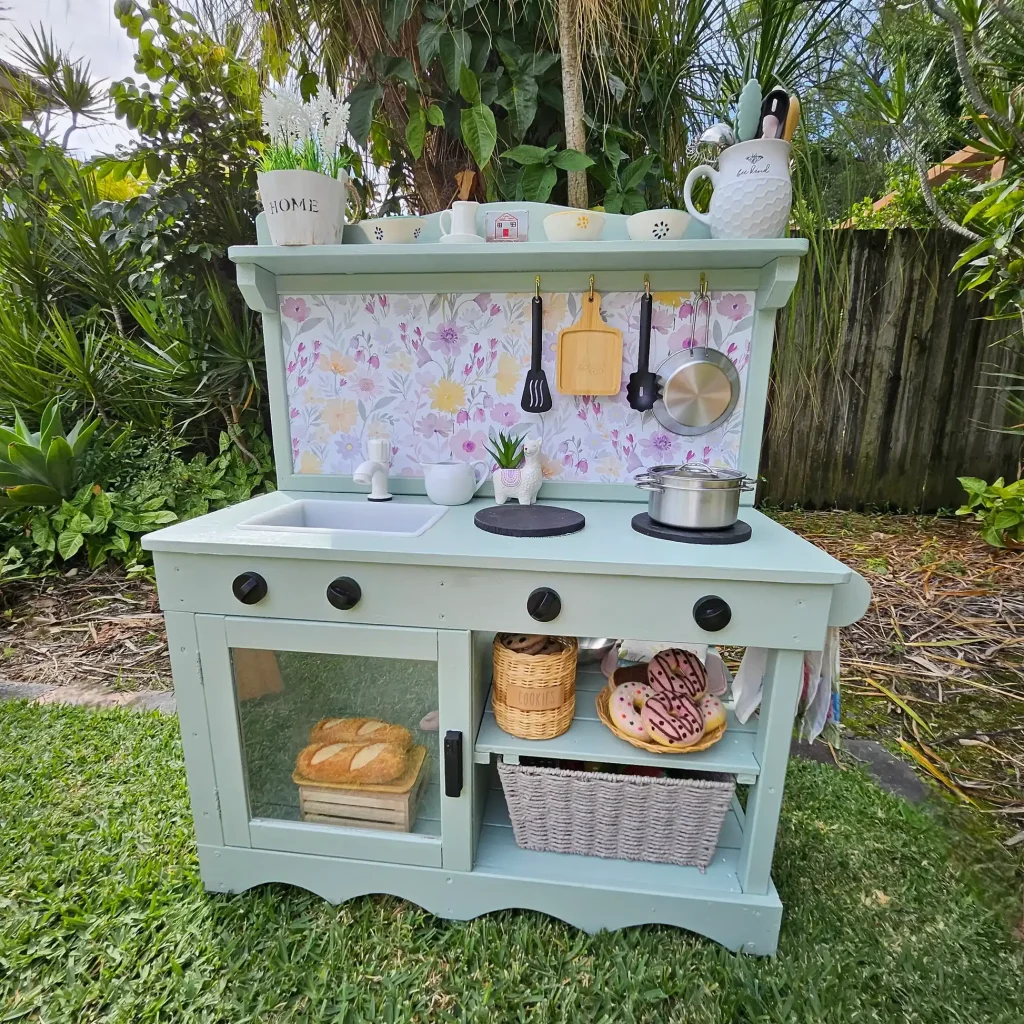
Mud kitchens already encourage sensory play, but a dedicated sensory bin section takes it to another level!
Set up multiple bins filled with different textures, such as:
- Mud (soft, wet soil)
- Sand (dry, grainy texture)
- Water beads (soft and squishy)
- Rice or pasta (great for scooping and pouring activities)
Adding scoops, funnels, and colanders makes this mud kitchen even more engaging. This is a perfect Montessori-inspired play idea that enhances fine motor skills, cognitive development, and sensory exploration.
21. Herb Garden Mud Kitchen
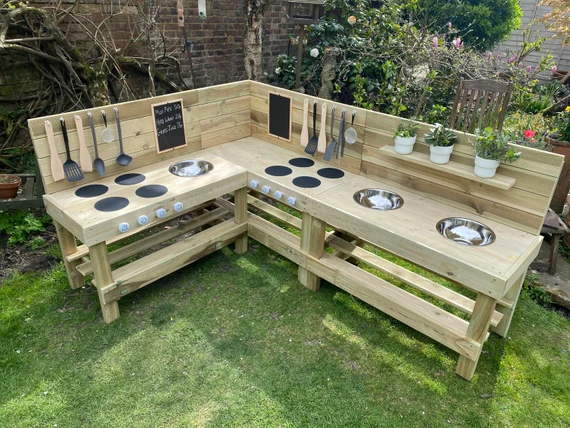
Why not mix gardening and mud play in one? A herb garden mud kitchen allows kids to grow and harvest their own ingredients for pretend cooking.
Dedicate a small raised garden bed or hanging planters next to the mud kitchen, planting child-friendly herbs like basil, mint, thyme, and chives. Kids can pick fresh leaves and use them in their imaginary soups, teas, and potions.
This setup teaches children about nature, plant growth, and sustainability, while also adding a fresh, fragrant touch to their play area.
22. Eco-Friendly Bamboo Mud Kitchen
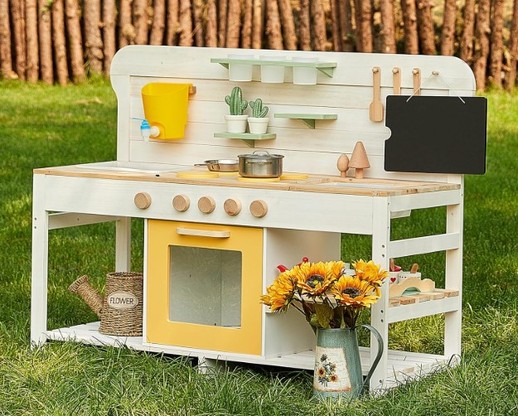
For a truly sustainable option, a bamboo mud kitchen is a wonderful choice. Bamboo is lightweight, durable, and naturally resistant to moisture, making it an ideal material for outdoor play.
A bamboo setup can include:
- A bamboo countertop for mixing mud creations
- Reclaimed bamboo poles as legs or shelves
- Woven baskets for storage
- Coconut shell bowls for added natural charm
This type of mud kitchen blends beautifully into nature-inspired, forestcore, or minimalist backyard designs.
23. Outdoor Learning Station Mud Kitchen

A mud kitchen can be more than just play—it can also be an educational space!
This idea incorporates learning elements like:
- Weather charts: Let kids track the daily temperature and record if it’s sunny, rainy, or windy.
- Mini science experiments: Provide measuring cups, vinegar, and baking soda for safe, exciting reactions.
- Storytelling prompts: Create a “recipe book” where kids write down or illustrate their favorite pretend dishes.
This setup encourages STEM learning, creativity, and independent thinking, making it great for both homeschooling families and curious little minds.
24. Recycled Tire Mud Kitchen
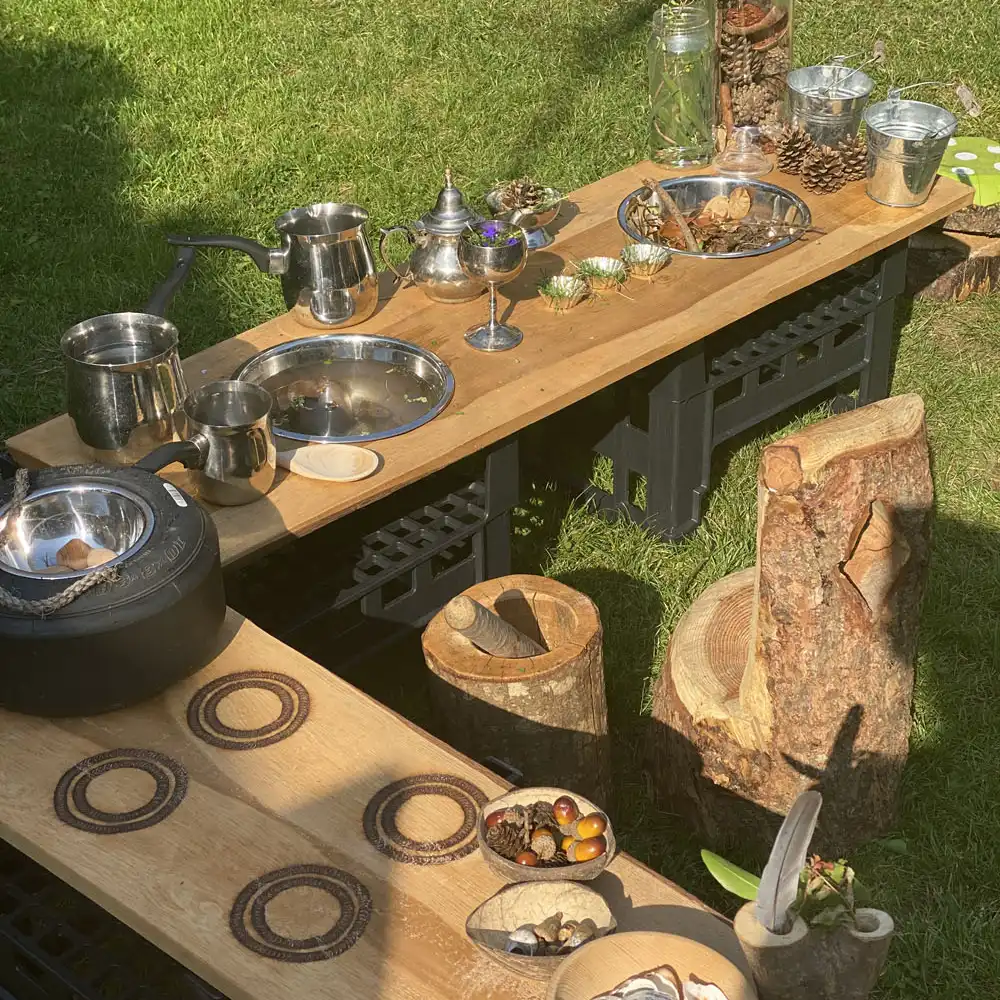
Old tires can be upcycled into unique, functional elements for a mud kitchen!
Some creative ways to use recycled tires include:
- Tire sink: Cut a tire in half, insert a plastic bowl, and use it as a large mixing station.
- Tire seating: Stack and paint tires for small stools.
- Tire shelves: Hang cut tires on a wall for rustic, curved storage spaces.
Not only is this an eco-friendly approach, but it also makes for a sturdy, durable play area that can withstand outdoor elements.
25. Holiday-Themed Mud Kitchen
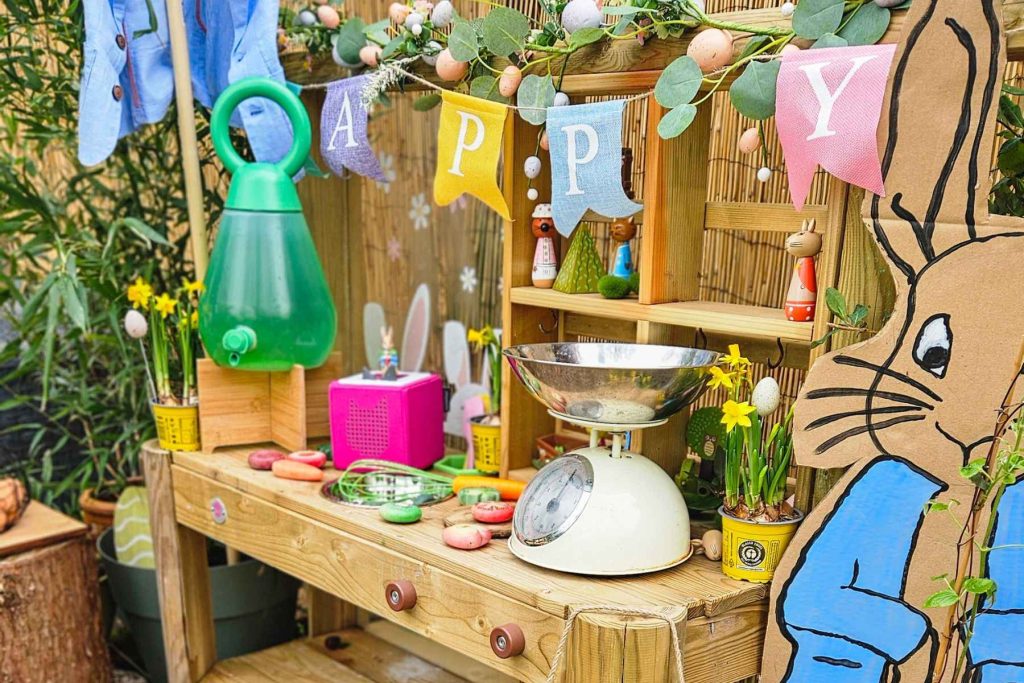
Keep things festive year-round by transforming your mud kitchen to match the seasons!
Ideas for each season:
- Spring: Add flower garlands, pastel-colored cups, and a pretend lemonade stand.
- Summer: Use a beach theme with seashells, sand, and tropical play food.
- Fall: Decorate with pumpkins, mini scarecrows, and pretend apple cider stations.
- Winter: Turn it into a “hot cocoa café” with wooden snowflakes and pretend marshmallows.
A rotating seasonal theme keeps kids engaged and excited about their mud kitchen throughout the year!
Conclusion: Why a Mud Kitchen is a Must-Have for Outdoor Play
Mud kitchens aren’t just about getting messy—they offer a wealth of developmental benefits for children:
Encourages creativity – Kids invent recipes, run pretend restaurants, and explore nature through play.
Enhances sensory learning – The different textures, scents, and interactions stimulate sensory development.
Promotes outdoor play – Encourages kids to spend more time outside instead of on screens.
Builds fine motor skills – Stirring, scooping, pouring, and mixing help strengthen hand-eye coordination.
Supports social interaction – Great for siblings, playdates, and cooperative play.
Whether you opt for a simple DIY project or a ready-made setup, a mud kitchen is an amazing addition to any backyard. It provides endless fun, creativity, and hands-on learning experiences that kids will cherish for years to come.
Which mud kitchen idea do you love the most? Let us know in the comments, and don’t forget to share your own creations on social media!
